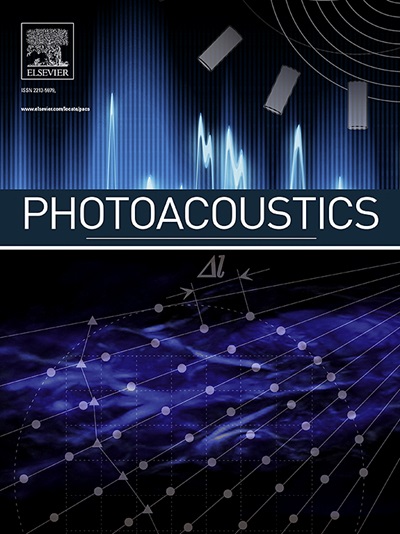Dual-wavelength photoacoustic imaging of sentinel lymph nodes in patients with melanoma and breast cancer
IF 6.8
1区 医学
Q1 ENGINEERING, BIOMEDICAL
引用次数: 0
Abstract
Sentinel lymph node (SLN) biopsy is an essential procedure for accurate disease staging and treatment planning in patients with melanoma and breast cancer. Conventional preoperative imaging primarily utilizes lymphoscintigraphy with technetium-99m (Tc-99m), which presents several limitations, including radiation exposure, logistical challenges, and potential delays in surgical workflow. Photoacoustic imaging (PAI) has emerged as a promising alternative, leveraging optical contrast provided by indocyanine green (ICG). A feasibility study was conducted at Erasmus MC, University Medical Center Rotterdam, to assess the potential of dual-wavelength PAI for SLN mapping. PAI was employed to perform spectroscopic measurements in healthy volunteers, supporting the development of an optimal excitation protocol. Subsequently, in the patient phase, SLN mapping was performed using PAI with ICG, and the results were compared to the standard-of-care method utilizing Tc-99m. The excitation wavelengths of 800 nm and 860 nm were selected for ratiometric imaging to effectively visualize ICG while suppressing clutter from hemoglobin and melanin. Among the eleven evaluated sentinel nodes, seven were successfully identified using PAI. The maximum SLN detection depth achieved with PAI was 22 mm. This study illustrates the feasibility of ICG-enhanced dual-wavelength PAI for preoperative SLN mapping in patients with melanoma and breast cancer, as an alternative to lymphoscintigraphy. Analysis of false-negative detections suggests improvements to PAI and optimal patient selection. The proposed ratiometric PAI methodology, compared to multiwavelength spectroscopic imaging, enables faster imaging speeds and facilitates the transition to cheaper light sources.
黑色素瘤和乳腺癌前哨淋巴结的双波长光声成像
前哨淋巴结(SLN)活检是黑色素瘤和乳腺癌患者准确疾病分期和治疗计划的重要步骤。传统的术前成像主要使用Tc-99m淋巴显像,但存在一些局限性,包括辐射暴露、后勤挑战和手术工作流程的潜在延迟。光声成像(PAI)已成为一种有前途的替代方案,利用吲哚菁绿(ICG)提供的光学对比度。鹿特丹大学医学中心Erasmus MC进行了一项可行性研究,以评估双波长PAI用于SLN定位的潜力。PAI被用于健康志愿者的光谱测量,以支持最佳激发方案的发展。随后,在患者期,使用PAI和ICG进行SLN制图,并将结果与使用Tc-99m的标准护理方法进行比较。选择800 nm和860 nm的激发波长进行比值成像,有效地显示ICG,同时抑制血红蛋白和黑色素的杂波。在11个评估的前哨淋巴结中,有7个使用PAI成功识别。PAI的最大SLN检测深度为22 mm。本研究说明了icg增强双波长PAI在黑色素瘤和乳腺癌患者的术前SLN定位中作为淋巴显像的替代方法的可行性。假阴性检测的分析提示PAI的改进和最佳患者选择。与多波长光谱成像相比,所提出的比率PAI方法可以实现更快的成像速度,并有利于向更便宜的光源过渡。
本文章由计算机程序翻译,如有差异,请以英文原文为准。
求助全文
约1分钟内获得全文
求助全文
来源期刊

Photoacoustics
Physics and Astronomy-Atomic and Molecular Physics, and Optics
CiteScore
11.40
自引率
16.50%
发文量
96
审稿时长
53 days
期刊介绍:
The open access Photoacoustics journal (PACS) aims to publish original research and review contributions in the field of photoacoustics-optoacoustics-thermoacoustics. This field utilizes acoustical and ultrasonic phenomena excited by electromagnetic radiation for the detection, visualization, and characterization of various materials and biological tissues, including living organisms.
Recent advancements in laser technologies, ultrasound detection approaches, inverse theory, and fast reconstruction algorithms have greatly supported the rapid progress in this field. The unique contrast provided by molecular absorption in photoacoustic-optoacoustic-thermoacoustic methods has allowed for addressing unmet biological and medical needs such as pre-clinical research, clinical imaging of vasculature, tissue and disease physiology, drug efficacy, surgery guidance, and therapy monitoring.
Applications of this field encompass a wide range of medical imaging and sensing applications, including cancer, vascular diseases, brain neurophysiology, ophthalmology, and diabetes. Moreover, photoacoustics-optoacoustics-thermoacoustics is a multidisciplinary field, with contributions from chemistry and nanotechnology, where novel materials such as biodegradable nanoparticles, organic dyes, targeted agents, theranostic probes, and genetically expressed markers are being actively developed.
These advanced materials have significantly improved the signal-to-noise ratio and tissue contrast in photoacoustic methods.
 求助内容:
求助内容: 应助结果提醒方式:
应助结果提醒方式:


